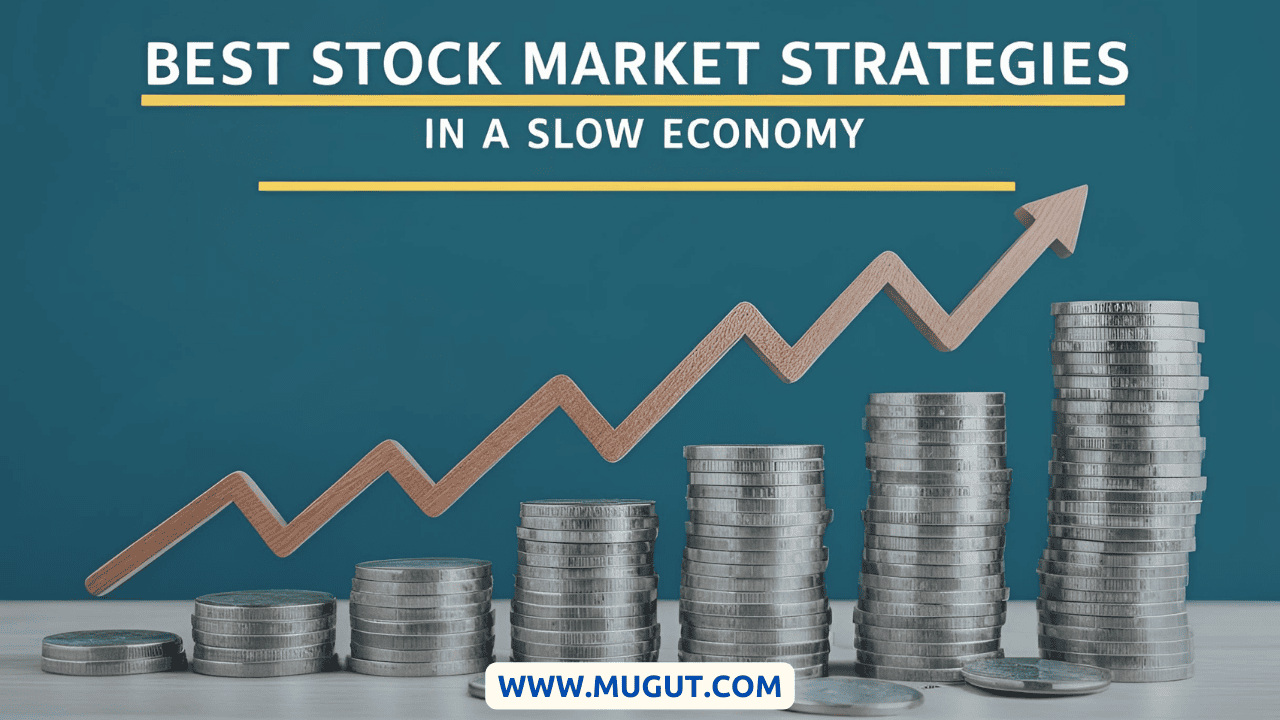In today’s time, when the economy is slowing down, people find the stock market risky. But the truth is that money can be made even in times of slow economy, if the strategy is strong. This article is about those smart and strong strategies that will help you grow even in times of slow economy.
What Is a Slow Economy?
First of all it is important to understand that What is the meaning of slow economy? When GDP growth rate decreases, jobs decrease, people spend less, then we call it slow or sluggish economy.
Indicators:
- GDP growth is low
- Companies’ revenue and profit grow slowly
- Consumer spending decreases
- There is uncertainty in the stock market
In such an environment the investor has to be cautious. But being cautious does not mean not investing, just the approach should be smart.
1. Focus on Defensive Stocks
When the economy slows down, then people stop buying non-essential items. But there are some things that people need it in every situation:
- Medicines
- Electricity, gas, water
- Daily groceries
Stocks of these sectors are called defensive stocks. Examples:
- Johnson & Johnson (Healthcare)
- Procter & Gamble (Consumer Staples)
- Duke Energy (Utilities)
These stocks are recession-proof. Their demand remains stable, hence their stock price does not fall much.
Strategy: Invest some part of your portfolio in defensive stocks for stability.
2. Dividend Stocks: Reliable Income Source
If the market is not growing, then what source of returns is left? Dividends.
Dividend stocks are those which give you a portion of your profit in cash at regular intervals. These are stable companies which have consistent cash flow.

Example companies:
- Coca-cola
- AT&T
- Realty Income Corp
Dividend yield You can get up to 3-6%, which is very useful in times of market downturn.
Strategy: Choose such dividend-paying stocks whose payout history is strong and whose fundamentals are solid.
3. Continue SIPs Without Panic
SIP (Systematic Investment Plan) is one such method of investment which works like magic for long-term investors. When the market is down, SIP buys more units. This reduces your average cost.
People stop their SIPs in times of slow economy, but they make mistakes, yes this is a mistake. This is the best time to invest at low cost.
Strategy: Keep SIP running, even increase it if possible.
4. Value Investing: Gems at Discount
There is fear in the market during slow economy. Stocks of many strong companies become irrationally cheap. Here value investors get the benefits.
Warren Buffett also says “Be greedy when others are fearful.”
Please check:
- Low Price-to-Earnings (P/E) ratio
- Consistent cash flow
- Low debt-to-equity ratio
Strategy: Invest in undervalued but fundamentally strong companies for long-term.
5. Avoid High-Risk Stocks & Speculation
In times of downturn, many people invest in penny stocks or speculative stocks to make quick profits. This could be dangerous.
There is less liquidity, fundamentals are weak, and there is more risk.
Example:
- Unknown small cap biotech firms
- Loss-making startups
Strategy: Avoid speculative investments unless you have high-risk tolerance.
6. Diversify Your Portfolio
Diversification means not putting all your money in one sector, stock or asset. In a slow economy one sector may be down but another sector may be stable or up.
Diversify in:
- Large-cap, mid-cap, small-cap stocks
- Equity + debt + gold
- Different geographies (US stocks + Indian stocks)
Strategy: Maintain a balanced portfolio to minimize the risk and ensure stable returns.
7. Use Cash Wisely for Opportunities
If you have maintained an emergency fund and have some extra cash, then invest it wisely in the slow economy. During the time of market correction, good stocks are available at discount.
But put all the money in one go. Use phased manner or follow buy the dip strategy.
Strategy: Invest a little at every dip with a long-term view.
8. Review & Rebalance Your Portfolio
It is necessary to update the portfolio when the market changes. Evaluate your investments once every 3-6 months.
Questions to ask:
- Is any sector overweight?
- Are any stocks consistently underperforming?
- Has your risk appetite changed?
Strategy: Adjust the portfolio so that your goals and market conditions align.
9. Don’t Let Emotions Control You
There is a lot of negative news in times of slow economy. Panic selling or fear-based decisions can cause significant damage to your portfolio.
Stock market is also an emotional game. Your patience and discipline helps you in win.
Strategy: Keep a long-term view. Take every decision on the basis of data and research.
10. Learn Continuously and Stay Updated
Market is always evolving. The investor who learns constantly is the one who becomes successful. If you get free time in the slow economy, use it wisely.
Learn from:
- Books (Rich Dad Poor Dad, The Intelligent Investor)
- YouTube finance creators
- Podcasts, blogs, and courses
Strategy: By investing some time every week in learning, your returns will definitely improve. As you will be able to make better and smart decisions after learning things.
Conclusion: Slow Economy = Smart Opportunity
Slow economy does not mean that one should stay away from the stock market. This is the time for smart investing. At a time when everyone is scared, some people are cleverly building their wealth.
Top Takeaways:
- Focus on defensive and dividend stocks
- Don’t stop investing in SIPs
- Do value investing
- Diversify and rebalance your portfolio
- Use cash smartly
- Avoid emotional investing
- keep learning
If you follow these strategies with a long-term mindset, your investments will grow even in times of a slow economy.
Let us know is this article helpful for you? If you have any suggestion or a question to ask then please comment down below the article. Thanks for read this article.
